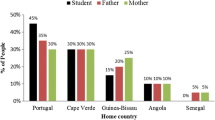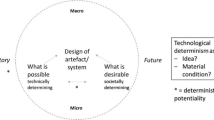Abstract
With increasing technological changes and needs in society, technology and engineering education has received much attention in school science. Yet, technology traditionally has been subordinated to science or simply taken as the application of science. This position has resulted in a limited understanding of teaching technological and engineering education. This study questions the traditional view of technology in school science by examining children’s action and learning in the course of designing and building cantilever bridges in science classrooms. We adapt Heidegger’s articulation of the four causes known to philosophy in the Greco-Roman tradition—causa materialis (material), causa formalis (form), causa finalis (purpose), and causa efficiens (effect-producing)—to analyze elementary children’s technology design activities. The study suggests that children’s technology has certain dimensions of knowing-how, i.e., there is an instrumentality that goes beyond scientific knowledge. We suggest that the practice of technology and engineering education, which mainly focuses on children’s scientific knowledge, needs to be reexamined and reframed to develop holistic ways of teaching technology.





Similar content being viewed by others
Notes
It is beyond the scope of our study to distinguish technology and engineering. Instead, we acknowledge technology in our study is discussed in the context of hands-on tasks such planning, designing, making, and building, which could be inseparable from the process of engineering. Thus, we do not differentiate technology and engineering in this work but refer them interchangeably.
Heidegger writes all relevant words in Greek letters; we introduce each word as Heidegger used it but then follow the Anglo-Saxon convention to use Roman transliterations.
Heidegger does not write about Technologie (technology), (a) the science of the transformation of materials into finished products that makes use of scientific and technical knowledge and (b) the totality of processes required for the production and transformation of raw materials. Instead, he writes about Technik (technology + technique), (a) the totality of measures and modes of operation to mobilize scientific knowledge for practical purposes and (b) the mode, method of proceeding, the execution of something.
A cantilever bridge consists of two halves, each strutting out from opposing points of a river or valley, joined in the middle where no support is required because the cantilevered halves are self-supporting.
References
Bennett, D., & Monahan, P. (2013). NYSCI design lag: No bored kids! In M. Honey & D. Kanter (Eds.), Design, make, play: Growing the next generation of STEM innovators (pp. 34–49). New York, NY: Routledge.
Brophy, S., Klein, S., Portsmore, M., & Rogers, C. (2008). Advancing engineering education in P–12 classrooms. Journal of Engineering Education, 97(3), 369–387.
Callon, M. (1991). Techno-economic networks and irreversibility. In J. Law (Ed.), A sociology of monsters: Essays on power, technology and domination (pp. 132–161). London: Routledge.
Carr, R., Bennett, L., & Strobel, J. (2012). Engineering in the K-12 STEM standards of the 50 U.S. States: An analysis of presence and extent. Journal of Engineering Education, 101(3), 539–564.
Cavanagh, S., & Trotter, A. (2008). Where is the ‘T’ in STEM? Education Week, 27, 17–19.
Council of Canadian Academies (2015). Some Assembly Required: STEM Skills and Canada’s Economic Productivity. Ottawa (ON): The Expert Panel on STEM Skills for the Future, Council of Canadian Academies.
Crismond, D. (2001). Learning and using science ideas when doing investigate-and-redesign tasks: A study of naïve, novice, and expert designers doing constrained and scaffolded design work. Journal of Research in Science Teaching, 38, 791–820.
Dohn, N. (2013). Situational interest in engineering design activities. International Journal of Science Education, 35(12), 2057–2078.
Fortus, D., Dershimer, R., Krajcik, J., Marx, R., & Mamlok-Naaman, R. (2004). Design-based science and student learning. Journal of Research in Science Teaching, 41, 1081–1110.
Gardner, P. (1992). The application of science to technology. Research in Science Education, 22, 140–148.
Goldman, S. L. (1990). Philosophy, engineering, and western culture. In P. T. Durbin (Ed.), Broad and narrow interpretations of philosophy of technology (pp. 125–152). Dordrecht: Kluwer Academic Publisher.
Gunstone, R. (1994). Technology education and science education: Engineering as a case study of relationships. Research in Science Education, 24, 129–136.
Guzey, S. S., Tank, K., Wang, H.-H., Roehrig, G., & Moore, T. (2014). A high-quality professional development for teachers of grades 3–6 for implementing engineering into classrooms. School Science and Mathematics, 114(3), 139–149.
Harel, I. (1991). Children designers: Interdisciplinary constructions for learning and knowing mathematics in a computer-rich school. Norwood, NJ: Ablex.
Harrison, M. (2011). Supporting the T and the E in STEM. Design and Technology Education: An International Journal, 16(1), 17–25.
Heidegger, M. (1977). Sein und Zeit [Being and time]. Tübingen: Niemeyer.
Heidegger, M. (2000). Gesamtausgabe. I. Abteilung: Veröffentlichte Schriften 1910–1976 Band 7: Vorträge und Aufsätze [Complete works part 1: Published writings 1910–1976 vol. 7: Talks and essays]. Frankfurt a/M: Vittorio Klostermann.
Ihde, D. (2010). Heidegger’s technologies: Postphenomenological perspectives. New York, NY: Fordham University Press.
Ingold, T. (2013). Making: Anthropology, archeology, art and architecture. London: Routledge.
Jordan, B., & Henderson, A. (1995). Interaction analysis: Foundations and practice. Journal of the Learning Sciences, 4, 39–103.
Kelly, T. (2010). Staking the claim for the ‘T’ in STEM. Journal of Technology Studies, 36(1), 2–11.
Kolodner, J., Camp, P., Crismond, D., Fasse, B., Gray, J., Holbrook, J., et al. (2003). Problem-based learning meets case-based reasoning in the middle-school science classroom: Putting Learning by Design™ into practice. Journal of the Learning Sciences, 12, 495–547.
Latour, B. (1988). Mixing humans and non-humans together: The sociology of a door-closer. Social Problems, 35, 298–310.
Latour, B. (1992). Aramis ou l’amour des techniques [Aramis or the love of technology]. Paris: Éditions la De´couverte.
Latour, B. (1999). Pandora’s hope: Essay on the reality of science studies. Cambridge: Harvard University Press.
Lave, J. (1993). The practice of learning. In S. Chaiklin & J. Lave (Eds.), Understanding practice: Perspectives on activity and context (pp. 3–32). Cambridge: Cambridge University Press.
Leont’ev, A. N. (1983). Izbrannye psixhologičeskie proizvedenija (tom 2) [Selected psychological works (Vol. 2)]. Moscow: Pedagogika.
Lewis, T. (2006). Design and Inquiry: Bases for an accommodation between science and technology education in the curriculum? Journal of Research in Science Teaching, 43(3), 255–281.
Marx, K., & Engels, F. (1978). Werke Band 3 [Works vol. 3]. Berlin: Dietz.
McGinn, R. (1991). Science, technology, and society. New Jersey: Prentice-Hall.
McRobbie, C., Stein, S., & Ginns, I. (2001). Exploring designerly thinking of students as novice designers. Research in Science Education, 31, 91–116.
Micham, C. (1978). Types of technology. Research in Philosophy & Technology, 1, 229–249.
Murphy, P., & McCormick, R. (1997). Problem solving in science and technology education. Research in Science Education, 27(3), 461–481.
National Research Council. (1996). National science education standards. Washington, DC: The National Academy Press.
National Research Council. (2012). A framework for science education. Washington, DC: The National Academy Press.
NGSS Lead States. (2013). Next generation science standards: For States, By States. Washington, DC: The National Academies Press.
Resnick, M., & Rosenbaum, E. (2013). Designing for tinkerability. In M. Honey & D. Kanter (Eds.), Design, make, play: Growing the next generation of STEM innovators (pp. 163–181). New York, NY: Routledge.
Ritchie, S., & Hampson, B. (1996). Learning in-the-making: A case study of science and technology projects in a year six classroom. Research in Science Education, 26(4), 391–407.
Rockland, R., Bloom, D., Carpinelli, J., Burr-Alexander, L., Hirsch, L., & Kimmel, H. (2010). Advancing the “E” in K-12 STEM education. Journal of Technology Studies, 36(1), 53–64.
Roth, W.-M. (1995). From “Wiggly structures” to “Unshaky towers”: Problem framing, solution finding, and negotiation of courses of actions during a civil engineering unit for elementary students. Research in Science Education, 25(4), 365–381.
Roth, W.-M. (1996a). Art and artifact of children’s designing: A situated cognition perspective. Journal of the Learning Sciences, 5, 129–166.
Roth, W.-M. (1996b). Knowledge diffusion in a grade 4-5 classroom during a unit on civil engineering: An analysis of a classroom community in terms of its changing resources and practices. Cognition and Instruction, 14, 179–220.
Roth, W.-M. (1998). Designing communities. Dordrecht: Kluwer Academic Publishers.
Roth, W.-M. (2001a). Learning science through technological design. Journal of Research in Science Teaching, 38, 768–790.
Roth, W.-M. (2001b). Modeling design as situated and distributed process. Learning and Instruction, 11, 211–239.
Roth, W.-M. (2005). Doing qualitative research: Praxis of methods. Rotterdam: Sense Publishers.
Roth, W.-M., & Barton, A. C. (2004). Rethinking scientific literacy. New York, NY: Routledge.
Sismondo, S. (2004). An introduction to science and technology studies. Malden, MA: Blackwell.
Vygotsky, L. S. (1987). The collected works of L. S. Vygotsky, Vol. 1: Problems of general psychology. New York, NY: Springer.
Waddington, D. (2005). A field guide to Heidegger: Understanding “the question concerning technology”. Educational Philosophy and Theory, 37(4), 567–583.
Welch, M. (2007). Learning to design: The continuum of engineering education. International Journal of Engineering Education, 23(1), 84–94.
Wendell, K., & Rogers, C. (2013). Engineering design-based science, science content performance, and science attitudes in elementary school. Journal of Engineering Education, 102(4), 513–540.
Author information
Authors and Affiliations
Corresponding author
Rights and permissions
About this article
Cite this article
Kim, M., Roth, WM. Re/Thinking the Nature of Technology in Science Classrooms. Interchange 47, 169–187 (2016). https://doi.org/10.1007/s10780-015-9273-3
Received:
Accepted:
Published:
Issue Date:
DOI: https://doi.org/10.1007/s10780-015-9273-3




